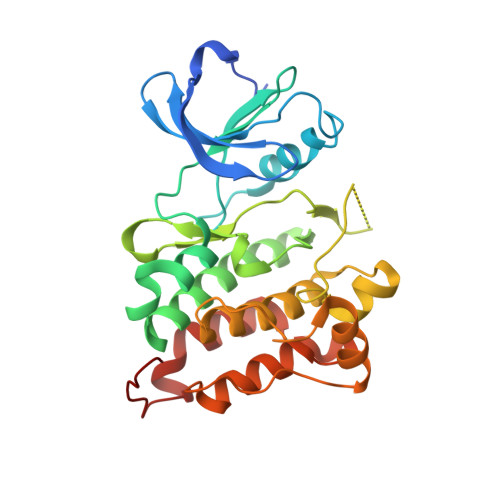Remarkably Stereospecific Utilization of ATP alpha , beta-Halomethylene Analogues by Protein Kinases.
Ni, F., Kung, A., Duan, Y., Shah, V., Amador, C.D., Guo, M., Fan, X., Chen, L., Chen, Y., McKenna, C.E., Zhang, C.(2017) J Am Chem Soc 139: 7701-7704
- PubMed: 28535041
- DOI: https://doi.org/10.1021/jacs.7b03266
- Primary Citation of Related Structures:
5XP5, 5XP7 - PubMed Abstract:
ATP analogues containing a CXY group in place of the α,β-bridging oxygen atom are powerful chemical probes for studying ATP-dependent enzymes. A limitation of such probes has been that conventional synthetic methods generate a mixture of diastereomers when the bridging carbon substitution is nonequivalent (X ≠ Y). We report here a novel method based on derivatization of a bisphosphonate precursor with a d-phenylglycine chiral auxiliary that enables preparation of the individual diastereomers of α,β-CHF-ATP and α,β-CHCl-ATP, which differ only in the configuration at the CHX carbon. When tested on a dozen divergent protein kinases, these individual diastereomers exhibit remarkable diastereospecificity (up to over 1000-fold) in utilization by the enzymes. This high selectivity can be exploited in an enzymatic approach to obtain the otherwise inaccessible diastereomers of α,β-CHBr-ATP. The crystal structure of a tyrosine kinase Src bound to α,β-CHX-ADP establishes the absolute configuration of the CHX carbon and helps clarify the origin of the remarkable diastereospecificity observed. We further synthesized the individual diastereomers of α,β-CHF-γ-thiol-ATP and demonstrated their utility in labeling a wide spectrum of kinase substrates. The novel ATP substrate analogues afforded by these two complementary strategies should have broad application in the study of the structure and function of ATP-dependent enzymes.
- Department of Chemistry, University of Southern California , Los Angeles, California 90089, United States.
Organizational Affiliation:


















